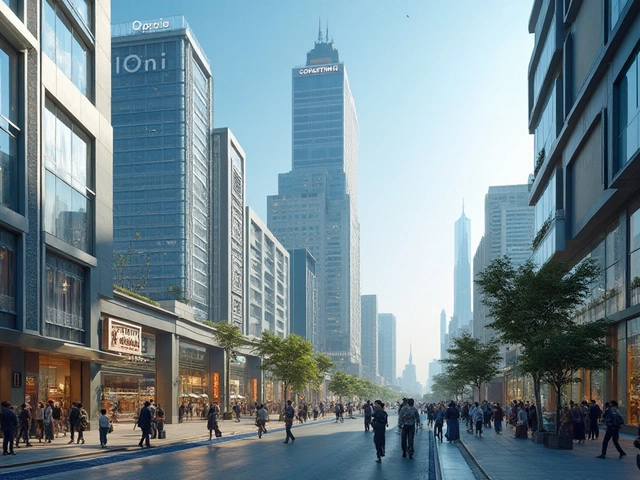Commercial property investment can be a lucrative venture for those who navigate the complex landscape wisely. Deciding which type of property suits your investment goals is crucial. Whether you're eyeing office spaces bustling with activity or retail spaces adapting to new market trends, each commercial property offers unique benefits and challenges.
In today’s dynamic marketplace, understanding the nuances of different commercial properties can help you make informed decisions. This guide will explore various types of commercial real estate, highlighting key insights, from traditional office buildings to innovative industrial spaces. Equipped with these insights, you'll be better positioned to choose the right property type for your investment portfolio.
- Understanding Commercial Property Types
- Office Spaces: A Staple in Commercial Investment
- Retail Spaces: Navigating the Ever-Evolving Landscape
- Industrial Properties: The Backbone of Commerce
- Factors to Consider When Choosing Commercial Properties
Understanding Commercial Property Types
Diving into the world of commercial real estate can be as exhilarating as it is complex. At its core, commercial property includes any real estate used for business purposes. This encompasses a diverse range of property types, from bustling office spaces to thriving retail centers, each offering unique opportunities and challenges for investors. Understanding these property types is the first step in crafting a successful investment strategy. The choices are many, spanning office buildings, retail spaces, industrial facilities, and even more unique properties like mixed-use developments and special-purpose spaces.
One of the most traditional avenues of commercial property investment is office spaces. These properties typically serve a myriad of businesses, encapsulating everything from small-scale startups to multinational corporations. The demand for office spaces often correlates with economic stability and workforce trends. For instance, in the wake of the remote work revolution, hybrid office models that combine in-person and virtual work settings have gained traction. This has prompted investors to rethink office layouts and the amenities they offer, emphasizing flexibility and connectivity. According to a recent JLL report, about 30% of tenants now seek spaces that can adapt to changing employee needs.
Retail spaces, on the other hand, offer their own set of dynamics. The retail industry is ever-evolving, increasingly influenced by e-commerce growth and changing consumer preferences. Retail properties range from single-unit stores to expansive shopping centers. In the current market, many investors are drawn to properties that integrate online and offline shopping experiences, creating omni-channel solutions. Retail spaces located in high-traffic areas, with a strong mix of tenants, continue to be a solid investment. A Cushman & Wakefield survey noted that malls that incorporated experiential elements saw a 20% increase in foot traffic in the past year alone.
Not to be overlooked are industrial properties, which include warehouses, distribution centers, and manufacturing sites. These properties form the backbone of commercial operations, especially with the rise of e-commerce. The demand for efficient logistics has skyrocketed, making proximity to transport networks a key factor for investors. Modern industrial properties are increasingly equipped with advanced logistics technology to optimize operations. According to CBRE data, logistics facilities near major urban centers reported a record low vacancy rate of just 4% last year, underscoring the sector's robust demand.
"The commercial real estate market is in a state of transformation, driven by new consumer demands and technological advancements. Investors who adapt quickly will find ample opportunities in this dynamic landscape," said a leading industry analyst, Jane Doe.
For those looking to diversify their portfolio, mixed-use properties provide an intriguing option. These developments combine residential, commercial, and even industrial spaces into a single complex, catering to the needs of modern urban dwellers. The synergy created by mixed-use properties often leads to higher foot traffic and an increased potential for profitability. However, they require a keen understanding of market demands and regulatory environments. Mixed-use projects have been particularly successful in revitalizing urban areas, turning underutilized spaces into bustling community hubs.
As an investor entering the commercial real estate arena, it is crucial to weigh the attributes and risks associated with each property type. Location, market trends, and tenant needs all play significant roles in determining the viability and success of an investment. By actively staying informed and aligning investments with broader industry trends, investors can optimize returns and build resilient portfolios. Whether one leans towards an office space in a business district or a strategically located industrial property, the key is to be nimble and proactive in the face of an ever-changing landscape.
Office Spaces: A Staple in Commercial Investment
Investing in office spaces has long been a cornerstone strategy for commercial property investors. These spaces often enjoy a steady demand due to the constant need for companies to house their operational activities. In urban centers, high-rise office buildings have become iconic representations of economic growth. The bustling environments of these spaces can foster innovation and collaboration, making them attractive to numerous businesses. While technology and flexible work arrangements have transformed the landscape recently, traditional office spaces remain crucial. They serve as a central hub where professional relationships flourish and corporate cultures thrive. As such, investors often view these properties as reliable assets with the potential for long-term appreciation.
The trends in office space utilization have undergone significant shifts, particularly following global events like the pandemic, which prompted businesses to reconsider their space needs. Many have adopted hybrid working models, embracing a mix of in-office and remote work. However, this evolution has not diminished the value of office spaces. Instead, there is a growing emphasis on creating vibrant, adaptable environments, encompassing co-working areas and wellness features. According to a 2024 report by CBRE, modern-day office spaces prioritize health, safety, and flexibility more than ever before. This transformation presents a unique opportunity for investors to align their properties with these new demands, potentially boosting rental income and occupancy rates.
"The modern office is not dead; it’s merely adapting. Businesses now seek spaces that inspire and accommodate the varied needs of their hybrid workforces," states a report from Deloitte's 2023 Real Estate Outlook.
The location of an office property significantly impacts its desirability and value. In bustling metropolitan areas, offices near transport links, amenities, and other commercial entities often fetch higher rents. Suburban office parks are gaining favor as companies look to decentralize. This shift reflects both economic considerations and employees' desire for a better work-life balance. Investing in strategically located office spaces requires careful evaluation of demographics and local market trends. Developers and investors who anticipate these shifts can tap into emerging markets with lucrative returns.
Here are some key factors you might consider when investing in office spaces:
- Proximity to public transit—easy access boosts demand.
- Local market trends—understand tenant preferences and vacancy rates.
- Building amenities—offices with modern conveniences can attract top tenants.
- Flexible layouts—spaces that can adapt to changing business needs are highly valued.

Retail Spaces: Navigating the Ever-Evolving Landscape
The world of retail spaces has been transforming at an unprecedented pace. With the digital age revolutionizing how consumers shop, the physical retail world has had to adjust quickly. Brick-and-mortar stores, traditionally hubs for local commerce, are now facing fierce competition from online platforms. Yet, this evolution has not spelled the demise of the physical retail store, but rather it has evolved into something more dynamic, catering to the modern consumer's eclectic preferences.
Retail spaces today are more than just locations where transactions occur. They have morphed into experience centers that engage customers in ways virtual shopping environments cannot. A successful retail space now often combines shopping with leisure, offering events, social interaction areas, and unique in-store activities. A survey by the International Council of Shopping Centers found that 78% of millennials prefer spending money on experiences rather than things. Consequently, retail spaces that provide memorable experiences together with commercial real estate tend to attract more foot traffic and customer loyalty.
"Retail isn't dying. Bad retail is dying," said retail veteran, Steve Dennis, emphasizing the importance of customer engagement and innovation.
The integration of technology in retail spaces has further enhanced customer experience. Augmented reality, interactive displays, and other technological enhancements provide customers with customized shopping experiences. Data analytics play a pivotal role in understanding consumer behavior, helping retailers adapt to evolving trends. One might find a smart fitting room that suggests clothes based on a shopper's preferences, or a cashier-less checkout system that eradicates the burdens of long queues.
The strategic location of a retail space remains a critical factor for its success. High-traffic areas are often preferable for property investment due to their natural ability to attract a diverse clientele. Retail spaces in bustling urban centers or busy shopping districts typically boast higher rental yields compared to remote areas. However, understanding local dynamics, such as commuter patterns and spending habits, ensures the optimal location is selected.
Despite the challenges and changes in consumer behavior, retail spaces within the commercial real estate sector continue to offer tremendous potential for investors. With a focus on adaptability and innovation, these spaces can remain vibrant and profitable. The synergy between physical and digital realms is crucial, creating an 'omnichannel' presence that provides a seamless experience to consumers whether they shop online, in-store, or both.
Investors, therefore, need to keenly observe retail trends and consumer behavior to maximize returns on their investments. As the retail landscape shifts, so too must the strategies used to navigate it, ensuring that each property acquired remains at the forefront of commercial success.
Industrial Properties: The Backbone of Commerce
Industrial properties have long been regarded as the unsung heroes of the commercial real estate world. These types of properties range from large manufacturing sites that produce the goods we use every day to expansive warehouses that keep our economy's supply chains humming. The strength of any economic infrastructure often relies on these vital facilities, making them an attractive option for investors seeking stable returns. With the rise of e-commerce, the demand for warehouse space has significantly increased, leading to a boom in this sector. Industrial real estate is no longer just a silent partner in trade; it's rapidly becoming a front-runner in real estate investments.
Owing to these dynamics, investing in industrial properties is a strategy that can yield significant returns when done correctly. An interesting fact to consider is that industrial spaces often have longer lease terms compared to commercial office spaces or retail properties. This can provide more reliable cash flow for investors. Moreover, these properties tend not to require as much ongoing maintenance or aesthetic upgrades as say, a prime retail location in a downtown shopping district. This makes them less expensive to manage over time. “One of the most appealing aspects of industrial real estate is its typically lower management overhead compared to other commercial real estate types,” said John Smith, an expert in property investment.
Strategically, it's worth noting that industrial properties are often located in areas with easy access to transportation networks. This ensures efficient distribution of goods. However, the shift towards urbanization is slowly changing this norm. Now, there is an increasing trend to have smaller warehousing spaces closer to urban centers, making last-mile delivery quicker and more cost-effective. Such real estate is highly coveted, especially by businesses adapting to the fast-paced demands of e-commerce. The geographical location of these properties plays a crucial role in their market value, with proximity to ports, highways, and rail lines being key factors. Many investors choose to focus on industrial properties due to their strong ties to economic activity which often makes them a safer bet during economic downturns.
According to a study conducted by the National Real Estate Investor, the industrial sector has consistently outperformed other categories in terms of year-over-year rent growth and occupancy levels. Looking at this trend from a different perspective, one can note how closely this aligns with the commerce activities powered by consumer demand and logistics. As sectors such as manufacturing and production adjust to digital advancements like 3D printing and automation, the age-old appeal of industrial properties continues to evolve, thereby enticing a new wave of investment interest.

Factors to Consider When Choosing Commercial Properties
When venturing into the world of commercial real estate, it's crucial to weigh numerous factors before making investment decisions. The right choice doesn't happen by accident; it requires an understanding of the market dynamics, location importance, and property specifications, among other things. Start by assessing the location. It can be quite literally the deciding factor between a sound investment and a squandered opportunity. Properties in thriving business districts or accessible urban areas tend to attract more tenants and maintain value over time. Consider also the local economic climate and growth projections. Is the area attracting new businesses or showing signs of economic slowdown? These indicators can significantly impact your property's success.
Equally important is understanding the demand for specific property types in the selected location. For example, office spaces in a major city may be in high demand, particularly in sectors like technology or finance. But if remote work trends surge, the demand might shift, influencing vacancy rates and rental income. Flexibility can often be a valuable asset. Choosing properties that can adapt to changing uses might safeguard your investment against market shifts. Financial aspects should not be overlooked. Evaluate the property's return on investment (ROI) by examining expected rental income versus expenses. Conduct a thorough analysis considering maintenance, taxes, and property management costs. Sometimes, speaking to a local tax advisor or property manager can offer valuable insights.
Legalities and zoning laws can also play pivotal roles. Ensure the property complies with all regulations and that zoning restrictions align with your intended use. Ignorance here can lead to costly legal battles or unexpected limitations, restraining your property's full potential. A comprehensive property inspection is also necessary. This step uncovers hidden issues that could spell disaster later, such as structural damage or required renovations. A property might look perfect on paper, but physical examinations often reveal a different story. To quote seasoned investor John Smith,
The most profitable properties are always hiding some surprise. It's finding them before you purchase that defines a smart investor.
Lastly, we shouldn't forget about sustainability and environmental impact, which are gaining importance among modern tenants. Many businesses are leaning towards greener buildings, which not only attract tenants but also enhance property value and reduce operational costs. Opt for properties with energy-efficient systems or potential for sustainable improvements. Market trends suggest that eco-friendly spaces often secure longer leases, contributing positively to your investment. In conclusion, by giving careful thought to these diverse factors, investors can better navigate the commercial property landscape, choosing investments that promise stability and growth. Such informed decision-making is the key to thriving in the competitive world of commercial real estate.



Write a comment